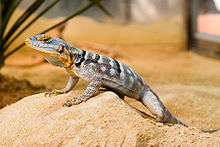California rock lizard
The California rock lizards are a genus (Petrosaurus) of New World lizards in the family Phrynosomatidae.[2]
| California rock lizards - Petrosaurus | |
|---|---|
 | |
| Baja blue rock lizard | |
| Scientific classification | |
| Kingdom: | Animalia |
| Phylum: | Chordata |
| Class: | Reptilia |
| Order: | Squamata |
| Suborder: | Iguania |
| Family: | Phrynosomatidae |
| Genus: | Petrosaurus Boulenger, 1885[1] |
| Species | |
|
See text | |
Geographic range
They are endemic to southern California and Baja California, Mexico.[3]
Habitat
This type of lizard lives almost exclusively on rock outcrops, boulder piles, and canyon walls, where it shelters under rocks. The habitat is arid and semiarid foothills and canyons along the western margin of the Colorado Desert.[4]
Reproduction
The courtship begins shortly after emergence in early spring. The eggs are laid around June and July.
Predators
The few predators that could pursue this lizard are collared lizards and avian predators, such as hawks, ravens, and roadrunners.
Species
The genus Petrosaurus contains three species.
- Petrosaurus mearnsi (Stejneger, 1894) - banded rock lizard
- Petrosaurus repens (Van Denburgh, 1895)
- Petrosaurus thalassinus (Cope, 1863) - Baja blue rock lizard[5]
gollark: I guess.
gollark: I don't routinely believe proverbs.
gollark: I… see.
gollark: They seem to be suggesting it varies between times and places.
gollark: What causes population goodness/badness then?
References
- Dahms Tierleben. www.dahmstierleben.de.
- Smith, H.M. and E.D. Brodie, Jr. 1982. Reptiles of North America, A Guide to Field Identification. Golden Press. New York. pp. 110-111.
- Stejneger, Leonhard and Thomas Barbour. 1917. A Check List of North American Amphibians and Reptiles. Harvard University Press. Cambridge, Massachusetts. pp. 50-52.
- http://www.socalcamping.com/fieldguide/reptile/bandedrocklizard.html
- The Reptile Database. www.reptile-database.org.
This article is issued from Wikipedia. The text is licensed under Creative Commons - Attribution - Sharealike. Additional terms may apply for the media files.